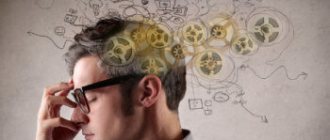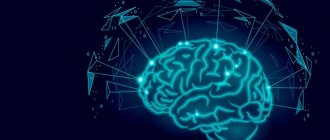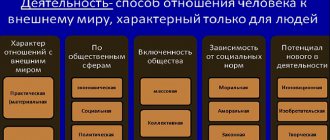Depending on the functions and individual characteristics, psychology distinguishes different types of memory in humans. Each differs in scope, activity, goal setting and involvement of other cognitive processes. The development of some occurs naturally, during growing up. The formation of others occurs especially intensively at a certain part of the life path. But most still require constant training. Therefore, it is important to know the characteristic features of each of them.
General classification
There are a large number of classifications of memory in domestic and foreign psychology. If you need to study this material in detail, you should look at the works of P. P. Blonsky, R. S. Nemov, F. N. Shemyakin, D. O. Hebb and other specialists.
There are only the main types; psychology identifies the following:
In fact, in addition to the main types of memory, descriptions of others can be found in the works of psychologists. For example, the classification according to the nature of mental activity sometimes also includes:
- sensory - visual, when fixation occurs at the moment of blinking;
- eidetic - combined, when visual impressions (which form its basis) are reinforced by others (auditory, gustatory, tactile), which allows subsequently to reproduce an unusually vivid image;
- social - preservation of socially significant information accumulated by previous generations;
- spatial - visual, allowing you to navigate the area well, remembering the features of the route.
The classification by duration is expanded by such a type as ultra-short-term memory (another name is the sensory register) - retaining information for several seconds. Includes iconic (for fixing visual material, lasts less than a second) and echoic (for acoustic, lasts 2 seconds).
Some psychologists classify types of memory into a separate group based on the type of organization of memorization:
- episodic - storage of specific information limited to a certain period (about a concert, for example);
- procedural (automatic) - a way of performing an action without taking into account its content, through skills brought to automaticity (driving skill).
Within each typology, several more species are distinguished. Psychologists are actively engaged in their classification to this day, constantly expanding and improving it.
Differences between short-term and long-term memory
Short-term and long-term types of memory represent two stages of one development. Long-term memory functions perfectly only with good short-term memory, which is a kind of buffer for the advancement of selected information.
Short-term memory allows you to remember what you hear and see without a special purpose or special effort. It is of great importance for the formation of life experience and the organization of thinking.
Long-term memory is the most complex and important of all types. Everything that is held in the field of attention for more than a few minutes is stored in its system for a long time. Only recycled and conscious materials go there. All this is reminiscent of the work of a modern computer, but more advanced, with huge amounts of various data.
The brain is like a computer
The main difference between short-term and long-term memory is the volume of memorized material. The limits of the human brain remain unknown. But even what is known is amazing - so much information is not contained in the largest libraries. In ordinary life, a person does not use all the functions and capabilities of his perfect brain structure. Due to the huge amount of information, there are serious problems with finding it.
By the nature of mental activity
Depending on what mental activity predominates in human activity during the recording and reproduction of information, there are the following types of memory.
Motor
Other names: motor.
Definition in psychology: fixation, retention and reproduction of motor algorithms, their amplitude, duration, speed, direction. It is formed in a part of the brain called the reticular activating system.
Why is it needed: contributes to the development of a number of skills (domestic, sports, labor), as well as learning to write.
Examples:
- the simplest movements that a person learns from childhood: how to walk, hold a spoon, brush your teeth, comb your hair;
- playing tennis, team sports, swimming, gymnastics, aerobics, exercise equipment;
- knitting, embroidery;
- cutting food, peeling vegetables and fruits;
- drawing, modeling, wood carving;
- dancing;
- playing musical instruments.
Who is especially well developed: athletes, secretaries, dancers, jewelers, watchmakers, surgeons, assembly line workers.
Development methods:
- Exercise. Master different sets of exercises.
- Develop fine motor skills (sculpt, assemble puzzles and Legos).
- To take dance classes. Learn new directions.
- Develop your hands.
- Learn to play musical instruments.
- Master the ten-finger touch typing method.
- Learn to use Chinese chopsticks.
- Perform exercises that involve completely different movements with your hands (for example, the left hand strokes the table in a circular motion, and the right hand, clenched into a fist, knocks on the table).
Emotional
Definition in psychology: fixation, retention and reproduction of feelings experienced by a person, as well as emotionally charged events. They can be positive and negative. They are formed by a part of the temporal part of the brain called the amygdala. They are deposited in the cerebral cortex. Thanks to the plasticity of the central nervous system, with each subsequent reproduction of the same situation, its brightness is smoothed out.
Why is it needed: feelings experienced and recorded by emotional memory become a kind of signaling system for a person. It either encourages him to act (if the experience was positive) or deters him from it (if the experience was negative). Forms a versatile personality, develops emotional intelligence, promotes social adaptation, and stimulates creativity.
Examples:
- empathy, sympathy (based on experience);
- Love;
- complexes;
- phobias;
- choice of social circle (people move away from those who hurt them in the past).
Who is especially well developed: actors (the famous system of K. S. Stanislavsky is based on it), teachers, psychologists, representatives of social professions.
Development methods:
- Keeping a diary.
- Meditation.
- “Anchoring” positive feelings and emotions.
- Bibliotherapy.
- Master networking and make as many new acquaintances as possible.
- Do what you like.
- Adrenaline: ride a roller coaster, jump from a parachute.
This is interesting. Psychologists say that a person remembers 3 feelings best - fear, suffering, surprise.
Semantic
Other names: verbal, logical, verbal-logical.
Definition in psychology: fixation, retention and reproduction by a person of heard, seen, spoken words.
Why is it needed: allows you to record and reproduce information based on generalized associations that reflect its most important aspects. Uses large structural units for memorization, which are called mnemonic supports. After a while, they are the ones who help a person remember the material.
Examples:
- retelling;
- memorizing poems;
- preparation for exams.
Who is especially well developed: artists, singers, pupils, students.
Development methods:
- Break information into blocks and isolate main ideas.
- Read complex texts every day that are far from your interests, try to understand and remember the information contained in them.
- Before going to bed, remember in detail the past day (week, month, quarter, six months, year).
Figurative
Other names: visual-figurative.
Definition in psychology: fixation, retention and reproduction of visual and sound images, as well as odors.
Why is it needed: to control the balance of functioning of both hemispheres of the brain.
Subtypes:
Who is especially well developed: musicians, artists, writers.
Development methods:
- Master the association method.
- Do neuroscience.
- Learn foreign languages.
This classification is considered basic in psychology. Particular attention is paid to the figurative type.
Related article: How to develop memory
Violations
Disorders include underdevelopment of long-term memory, when a person simply does not know how to correctly encode and reproduce information, and complete amnesia, which is characterized primarily by damage to the hippocampus. If in the first situation everything can be corrected through constant training, then in the second the forecasts most often remain unpredictable.
Causes
Physiological:
- asthenia;
- liver intoxication;
- damage to the central nervous system and brain: head injury, post-stroke condition;
- intellectual disorder, schizophrenia;
- chronic alcohol or drug intoxication.
Mental:
- overwork;
- neuroses;
- constant stress;
- excessive emotional and mental stress;
- depression;
- psychotrauma;
- dysthymia: constant bad mood.
Household:
- poor nutrition;
- lack of sleep;
- excessive physical and intellectual stress;
- improper planning of the day, lack of routine.
Symptoms
- Difficulties with conscious memorization: poems, dates, exam material learned by heart are poorly retained in memory and are reproduced with errors;
- inability to remember events from the distant or near past, memory lapses;
- confusion, violation of cause-and-effect relationships;
- forgetfulness in basic everyday situations: didn’t make a report, didn’t come to a meeting, didn’t buy bread for home;
- social maladjustment;
- decreased mental capacity and performance;
- inattention, inability to focus and concentrate;
- confusion.
If violations of short-term memory lead primarily to everyday problems (when you don’t remember what you did 5 minutes ago), then the consequences of damage to long-term memory affect almost all areas of life. At work, this leads to poor performance of one’s duties, and in the family – to the breakdown of personal relationships. The person turns out to be socially maladapted. Even if his DVP is simply poorly developed, he will not be successful compared to other students (students, employees), not to mention various forms of amnesia.
For more information about what causes memory impairments, how they manifest themselves and how to get rid of them, read our separate article.
By the nature of memorization goals
Depending on the presence or absence of goal setting in the process of memorizing and reproducing information, there are the following types of memory.
Involuntary
Other names: non-mediated.
Definition in psychology: when a person does not have any specific goal when fixing, holding and reproducing any images.
Why is it needed: enhances motivation.
Examples:
- play activities in childhood;
- human life experience.
With the help of gaming activities, you can quickly and easily develop all other types of memory in a child.
You can forget the address of a store that a person went to several times, just because he was poorly served there. Or you can remember where the cafe is, having gone there only once, if you sat there in pleasant company.
Development methods: formed naturally.
free
Other names: mediated.
Definition in psychology: a type of memory when, when fixing, retaining and reproducing images, a person is guided by a specific goal (for example, learning a poem by heart).
Why is it needed: for a person to acquire professional and other special knowledge and skills.
Examples:
- retelling, memorizing poems, preparing for exams;
- driving lessons and acquisition of other professional skills.
Any development methods that set a specific goal are suitable. For example, learn a poem, remember 20 out of 50 words, retell the text, etc.
How does a person remember
What kind of mood does a person have - types in psychology
What kind of memory a person has depends on the type of his activity and characteristic features.
Additional Information. It is known that blind and deaf people have heightened other senses. The perception of the world and types of memory change.
Receipt of signals
The human brain is a perfect device. He is capable of retaining and restoring a huge amount of information, but is selective in remembering and reproducing. What happens in ordinary conscious life does not linger in a person’s memory for long. There are laws here:
- what is used in practice is better absorbed;
- It’s easier to remember new things by associating them with familiar concepts;
- new information overlaps similar old information;
- for better memorization there is an optimal row length;
- repetition of information promotes better memorization;
- unfinished actions, tasks, unspoken phrases are retained in memory longer.
All data enters the brain in different ways. Scientists suggest that all parts of the brain are involved in the processes of remembering, storing and retrieving data.
By duration of storage
The amount of stored information is always important for a person of any age. Why does someone remember facts from the most remote corners of childhood, while others cannot learn their own phone number? It turns out that the matter is not only in abilities, but also in what type of memory is developed in a person. After all, it also differs in the retention time of the material.
Depending on the duration of information retention, psychology distinguishes three types of memory.
Operational
Other names: working, intermediate.
Definition in psychology: when a person needs to isolate only the most relevant images and actions from instant perception.
Why is it needed: exclusively for performing specific actions that are necessary only at the moment. As soon as the goal is achieved, the information is immediately forgotten.
Examples: reading and cheating.
Development methods: perform exercises to train attention.
Controversial point. Psychologists argue whether RAM should be classified as a separate type. A number of experts believe that this is one of the subtypes of short-term. Others call it an intermediate link between short-term and long-term.
Short term
Other names: short-term, KVP.
Definition in psychology: short-term storage of information after a single short-term perception, when immediate reproduction is required.
Why is it needed: allows the mechanisms of experience accumulation to function fully. The volume and accuracy of long-term memory depends on it. If the information was poorly recorded in the KVP, it will transfer to the DVP deformed.
An example is everyday, routine work (washing dishes in a certain sequence, performing daily tasks according to a schedule), which must be done here and now.
Development methods:
- Use online brain trainers.
- Repeat the same material over and over again for a long time.
- Use the simplification method: break the material into meaningful blocks so that it is easier to remember.
- Master the association method.
- Use the emotional type of memory: to more clearly record an event, remember the feelings that it evokes in you.
Study methods
To study a person’s ability to remember and process information, they use:
- Collection of information - studying the biography of the subject, observation, conducting experiments and tests, studying the results of activities.
- Analytical biochemistry. Conducted based on the results of clinical studies.
- Electrophysiology. Brain activity is recorded using magnetic resonance imaging.
- Pharmacology. The effects of various stimulant drugs on brain activity are being studied.
- Clinical psychophysiology. The subject's behavior is observed in a clinical laboratory setting.
If necessary, it is possible to study not only human memory. Scientists conduct experiments on mammals, plants and even microorganisms.
Medical supplies
The use of medications or dietary supplements does not lead to any negative consequences. However, when choosing products, it is important to take into account the person’s age, possible side effects, contraindications, as well as their effectiveness. To do this, just study the instructions and read reviews on the Internet. Additionally, it is recommended to consult a doctor, which is especially important for people with chronic diseases. What should you take to improve your memory?
Over-the-counter
Glycine has become the most popular drug for eliminating inattention and strengthening memory in Russia. The drug is inexpensive and quite effective. Its main advantage is not only the effect on memory, but also the reduction of stress. It is enough to take Glycine 1 tablet 3 times a day.
What other drugs can you pay attention to:
- Vitrum Memory;
- Undevit;
- Bilobil;
- Intellan;
- Aminalon.
All of them have a positive effect on memory quality. These tools are especially effective for schoolchildren, students, and anyone whose work requires interaction with large amounts of information.
Prescription
You can get them only after consulting a doctor. All of them are dispensed from the pharmacy strictly according to a prescription. Such medications easily eliminate inattention, relieve forgetfulness, and also have a special effect on the body if necessary. Piracetam has gained great popularity, as it reduces the risk of developing Alzheimer's disease, while simultaneously strengthening memory and eliminating circulatory disorders in the brain. Also known in our country is Cavinton, which improves the condition after a stroke and other brain diseases. Additionally you can consider:
- Phezam;
- Nootropil;
- Phenotropil;
- Encephabol;
- Picamilon;
- Cerebrolysin;
- Noofen.
For prescription drugs, the list of possible side effects and contraindications is much wider, which must be taken into account.
Taking medications or dietary supplements alone is not enough to develop memory. They should be used exclusively as an additional method in combination with others.
Emotional memory
Emotional memory contains all memories of experienced emotions and feelings. A feature of emotional memory is its brightness even after many years after the emotional outburst received. Usually, supported by an emotional impulse, it stores information for a long time and firmly. This may be due to the fact that, under the influence of strong emotions, adrenal hormones are included in the memorization mechanism, which are not involved in normal memorization.
Sometimes primary emotions are replaced by secondary ones, sometimes opposite ones, and then we overestimate our attitude towards events that once took place.
The development of the emotional type of memory helps to increase a person’s intellectual potential. Both success and comfortable emotional state in the family and society depend on the development of emotional memory. Works of art, wildlife, and fiction stimulate the development of imaginative thinking, which also contributes to the development of emotional memory.
Functions of emotional memory:
- Accumulation and reproduction of emotional experience associated with the event that caused the emotion.
- Formation of emotional intelligence.
- Influence on the development of personality and its creative abilities.
Through memory for emotional states, we make decisions about our next steps, we have the opportunity to learn from our mistakes and repeat successful experiences. The functions of emotional memory make its contribution to the formation of personality very significant.
Thanks to the emotional type of memory, we know how to suffer, rejoice, and sympathize. Once experienced feelings hold us back from something, encourage us to do something. Emotions are involved in the mechanism that motivates us to action. It is not thinking, but emotions that charge us with energy.
Figurative memory
Figurative memory is a repository of sounds, smells, and visual ideas. Visual-figurative memory stores material in the form of visual, auditory and other images. Therefore, several separate types of figurative memory are distinguished, such as auditory (try to remember the purring of a kitten or the crackling of brushes in a fire), visual figurative memory (the face of a loved one or a favorite vase - remember?), olfactory (the smell of a familiar perfume or just freshly cut grass), tactile (the touch of a warm hand or the pain of an injection), taste (the sourness of a slice of lemon or the sweetness of a banana). Visual-figurative memory is especially important in creative activity.
Our brain prefers to perceive the world by processing information in both hemispheres: the right one perceives the image, and the left one selects words for it. By developing figurative memory, we fill the gap caused by the lack of images: in the modern world there is a lot of information, but the bulk of it does not involve the right hemisphere in its work, an imbalance arises, as a result of which it is increasingly difficult for us to remember, maintain attention, and concentrate. The development of figurative memory helps to engage the right hemisphere, using the imagination. By imagining, we remember easily. Having understood the material, we create an image that consolidates understanding and gain knowledge.
There are visual, auditory, motor-auditory memory, visual-motor-auditory memory. These are the types of so-called sensory memory that play the most important role in learning. Knowing what type of memory predominates in a student, you can take a differentiated approach to the process of his learning, achieving better memorization results. The teacher must ensure that as many senses as possible participate in the process of learning the material. At one time, the famous teacher K.D. drew attention to this. Ushinsky.
Diagnostics
To find out how well a person's long-term memory is developed, various test methods are used.
Method No. 1. Memorizing words that are logically unrelated to each other
The bottom line. The subjects are given 2 lists of words (for children 6-12 years old one will be enough), which are logically unrelated to each other. Each of them is numbered.
Recommended Material:
Task options:
- Lists can be read aloud (without allowing subjects to write them down). If the words are read out, this must be done 2-3 times for adults and 4-5 times for children 6-12 years old.
- They can be written on the board.
- They can be distributed on separate pieces of paper to each subject.
Exercise:
- Listen/read the lists of words carefully and try to remember them.
- After listening/reading multiple times, try to reproduce it on paper. Preferably in the same order.
- Next, you need to be distracted by some other activity.
- After half an hour, the lists are read/listened to one more time and played again.
- The same thing is done twice more - the next day and a week later. The words are read/listened to again, but only once.
The results of all 4 tests are calculated using the following formula:
C (DVP coefficient) = B (number of correctly reproduced words): A (total number of words) x 100.
Next, the arithmetic mean of all 4 tests is found and based on the resulting result, conclusions are drawn:
Method No. 2. Memorizing text with semantic connections
The essence of the technique is almost the same. Only the text is not read aloud, but is distributed to each subject. At the same time, attention is drawn to the fact that the main thoughts are highlighted in bold, which must then be reproduced. That is, it is not necessary to memorize the sentences themselves and the entire text.
This technique is used to diagnose DVP in adolescents (13-17 years old) and adults.
Card with text:
You need to reproduce the main ideas of the text immediately after reading, then after half an hour, the next day and a week later. The results of all 4 tests are calculated using the formula:
C (DVP coefficient) = B (number of correctly reproduced thoughts): A (total number of highlights in the text) x 100.
Next, the arithmetic mean of all 4 tests is found and, based on the resulting result, conclusions are drawn according to the table above.
In case of serious impairments of long-term memory, laboratory diagnostic methods (EEG, CT, MRI, ultrasound) are performed.
What types of memory can be developed
Throughout his life, a person uses different types of memory. In the left and right hemispheres, acquired various knowledge is deposited like “bricks”. To extract the necessary information sometimes requires considerable effort. With the help of forgetting, the nervous system is unloaded; this is considered a normal process.
Bad memory and good memory sometimes mean completely different things. For some, it is important to remember everyday trifles, for others, people and events, and others are interested in the amount of information before an exam or an important presentation. Therefore, it is important to know what kind of memory needs to be developed to solve problems. Conventionally, it is customary to distinguish between two types:
- Natural memory. It is as it is, and is inherent in nature itself. Everyone uses it without exception.
- Artificial. It must be trained and developed throughout life.
There are people with phenomenal memory. Others can't hold anything in their head for more than a minute. Experts are confident that the ability to remember can be trained and developed, just like your own body. If you take this seriously, you can achieve significant success.
Memory Features
Important! The testing method can reveal the type of memory in any person, as well as the presence of any pathologies.
Causes of memory impairment and increased forgetfulness:
- age-related changes;
- Alzheimer's disease and some other diseases;
- lack of water in the body;
- absent-mindedness;
- bad dream.
Memory development has a positive effect on a person’s abilities. For adults, this process is more difficult, since regular training is not needed in monotonous work and everyday life.
Useful qualities to improve the memorization process:
- attentiveness and observation;
- interest in life, positive attitude;
- organization in everyday life;
- use of imaginative thinking;
- learning foreign languages;
- Reading books;
- memorizing poems and quotes;
- Mind games;
- physical exercise;
- proper nutrition;
- the ability to correctly express your memories;
- reflections before going to bed about the past day, listing tasks for the next.
If you follow the advice and recommendations of experts and know the characteristics of human memory, then its comprehensive development is possible. Developed memory is valued and helps to achieve a high position in society. This is also important for successful work in all areas.
Methods of training and development
If a person does not have physiological disorders, he can improve memory function: speed up memorization and increase volume. Simple exercises designed for children and adults are suitable for this.
Development in children
You can notice a lag in the development of memory in children at a young age, but until the age of 3-4 years, parents do not worry about it, and turn to a psychologist when the child is about to go to 1st grade. And although time is lost, the situation can be helped.
To develop visual memory, the “Story Pictures” method is used. Cards are laid out in front of the child, depicting a short story. The preschooler examines it for some time. When he is ready, the adult needs to swap the cards. The child’s task is to restore the sequence of actions. For auditory memory, exercises for memorizing words and numbers are suitable. You need to start with three, gradually working up to 6–7.
Development in adults
You can train your memorization skill with any material: retell the plot of a movie, memorize poems, phone numbers, words of a foreign language. You can study during a break at work, using improvised objects. For example, lay out stationery on the table, take a photo, change places and arrange them as they were in the beginning.











